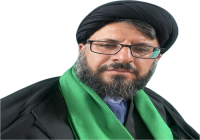The Number of Holy Imams Among Ahl al-Bayt (A.S.)
The Number of Holy Imams Among Ahl al-Bayt (A.S.)
Jabir ibn Samura: At the twilight of the Friday when Aslami was stoned, I heard the Messenger of God (S.A.W.) say: This religion will perpetuate until either the Resurrection comes about or twelve caliphs who are all from the Quraysh rule over you.
I heard the Holy Prophet (S.A.W.) said: People's affairs will move on as long as twelve men have Walaya (mastership) over them. Then the Holy Prophet (S.A.W.) said something which was unclear to me. I asked my father what the Holy Prophet (S.A.W.) said. My father said that the Prophet said: They are all from Quraysh.
Al-Imam al-Baqir (A.S.): The Holy Prophet (S.A.W.) has said: Of my children, twelve will be pioneers who are highborn, Muhaddath, (the divine personalities connected to the angels and the angels speak with him) and discerning.
The last one of them is the rightful Qa'im (the one who will rise) who will prevail justice all over the world after it had been filled up with oppression.
Al-Imam al-Baqir (A.S.): Quoting his father who quoted from al-Husayn(A.S.): I and my brother went to see my grandfather the Apostle of Allah (S.A.W.). The Holy Prophet (S.A.W.) seated me on one side of his lap and al-Hasan on the other. Then kissed us and said: May my father be sacrificed to you two benevolent Imams. Allah has selected you through me and your parents and has chosen through your progeny O Husayn the nine Imams whose last one will be their Qa'im and you are all considered equal in virtues and status by Allah.
Imam Baqir (A.S.): The twelve Imams who are from among the progeny of Muhammad(S.A.W.) are all Muhaddath. They are the children of the Apostle of Allah (S.A.W.) and the children of Ali (A.S.); the Prophet (S.A.W.) and Ali (A.S.) being considered as fathers.
A Research on Traditions Regarding the Number of Imams
The content of this chapter's traditions is repeated with different wordings in many Sunni sources as well as in some Shi'i hadith sources. The textual difference in these hadiths denotes some serious political considerations in relating them. Thus in some, the word "next" is omitted and "caliph" is replaced with "Amir" and is some instances "caliph" is replaced with "qayyim (custodian)" or "malak (king)". Still in some, the quintessence of Islam is associated till Resurrection with the Holy Prophet's (S.A.W.) twelve Caliphs, but in others there is no sign of this relation. In some hadiths, the Islamic community's expediencies are intertwined to their Walaya (mastership) and in some they are not; as it is also true with the natural current affairs.
The significant and noteworthy point is that these traditions are common in two basic issues, in spite of their inconsistencies:
1. The Prophet of Islam (S.A.W.) has introduced to people the best ones who could head the Islamic community for long years after him.
2. The number of Imams whose leadership has been confirmed by the Holy Prophet (S.A.W.) is twelve. This fact is further elucidated when we refer to the traditions narrated by the advocates of Ahl al-Bayt. Thereby, we can see that besides confirming the above mentioned content, these traditions elaborate more exactly on the names and specifications of the prophet's (S.A.W.) caliphs. It will also become clear that whenever the narrator did not hear the prophet's (S.A.W.) voice. His Holiness (S.A.W.) had said "All of them are from Bani Hashim" as is pointed out in some traditions; or he had said something implying the above. Similarly, Ali (A.S.) is quoted as saying: "Verily the Imams and religious leaders are from the Quraysh which came into existence from Hashim (and emerged through Fatima's (A.S.) progeny); Imamate and caliphate is not valid except for them and caliphs other than them are not qualified."
Undoubtedly, political considerations have caused elimination of the detailed specifications of the Holy Prophet's (S.A.W.) twelve caliphs, but so much of what has remained intact suffices to bring light to the reality, for according to some researchers who say: "Hadiths implying that the number of caliphs after the Holy Prophet(S.A.W.) are twelve, have become famous in many ways", and by explaining the time and defining the status quo and geographical situation, it is understood that the Holy Prophet's (S.A.W.) intention of this hadith is twelve Imams from his Ahl al-Bayt and Itrat and it can not be applied to caliphs from the Sahabah (the companions) since their number is lesser than twelve. Of these traditions are considered along with the widely transmitted Hadith of Thaqalayn and other traditions presented in this book introducing the Ahl al-Bayt and the necessity of appealing to them, it will be clear that the Holy Prophet of Islam(S.A.W.) above all, had exactly and clearly talked about the future leadership of Islam and the Imam after him.
Source: The Image of Ahl al-Bayt (A.S.) in The Qur'an and Hadith
By: Muhammadi Rayshahri










